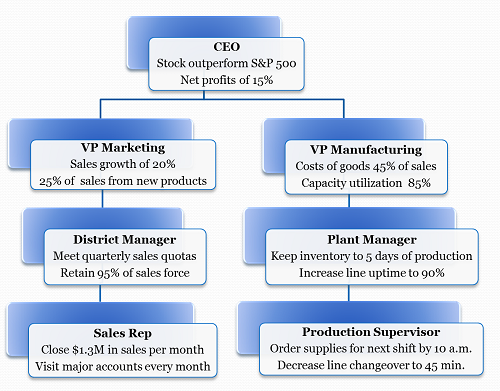When you walk in the room, who shows up for Read more →
Management by Objectives? Or Leading with Goals?
Posted Thursday, February 7, 2013Allen Slade
Here is a simple recipe for a post on a leadership blog:
Are you doing bad things too much? Do good things more. You and your employees will prosper. Your comments welcome below. And follow us on Facebook!
Here are some leadership contrasts that fit the recipe:
| Bad Things: | Good Things: |
| Managing | Leading |
| Controlling | Empowering |
| Commanding | Engaging |
| Reacting | Anticipating |
If today’s topic is “Management by Objectives? Or Leading with Goals?” we probably agree that it is better to lead people than to manage objectives. As a society, we value leaders and leadership. That’s one reason I am a leadership coach, not a management coach.
Hang on, it’s not that easy. The best leaders are good managers, too. Empowerment requires controls (like accounting and scorecards). You need to engage, but in a fire, you need to command. And, you need to react to what no one could anticipate.
Bottom line: If you are a leader, you may need to use Management by Objectives. And, as a manager, you should Lead with Goals. Let’s take a closer look:
Leading with Goals is a powerful tool for influence. As a leader, have a goal setting conversation with each employee at the beginning of the year. Encourage them to set SMART goals. Use those goals for continuous improvement throughout the year. And use those goals as the focus of the performance review at the end of the year. Make sure each employee has at least three goals but not so many goals they are overwhelmed.
Management by Objectives is a bit different. In MBO, managers assign every individual a specialized set of objectives or goals. Performance reviews are conducted periodically, and rewards are given to individuals based on performance against goals.
MBO combines the motivational power of goal setting with the coordination power of strategy formulation. MBO systems create a cascading set of goals.
The CEO has goals that cascade to the VPs. Their goals cascade down through their functions. If all goals are met at one level (meet quarterly sales quotas), you should meet the goals at higher levels (sales growth of 20%).
So, which is better? Management by Objectives or Leading with Goals?
Research indicates that goals increase performance. When employees participate in setting their goals, they have higher commitment to the goals. So, with MBO, the top-down goals may undermine motivation somewhat. Leading with goals, so long as you use participative goals setting, will increase performance a bit more more. Still, top-down goals are better than no goals, so MBO is better than nothing.
Furthermore, MBO is better at cross-group coordination than purely participative goal setting. At the extreme, set-your-own-goals can lead to organizational chaos. If Marketing sets stretch sales goals, but Manufacturing sets quality goals rather than capacity goals, you may sell more than you can make. MBO provides the advantage of linking all goals to each other and to the organization’s strategy.
My advice to those at the top: Don’t think either MBO or Leading by Goals. Do both well. Maximize coordination power of MBO by linking goals throughout the organization while maximizing the motivational power of goal setting by engaging employees fully.
One way to do this is the double cascade. Strategy formulation starts at the top and is cascaded down. Then, all levels give feedback on the strategy. Next, preliminary goals are cascaded down. At every level, employees and managers sign up for SMART goals and give feedback up the chain. This extra round of two-way communication and coordination increases the quality of the decisions made and ensures that the resulting goals will gain traction throughout the organization.
For managers in the middle, your company either has management by objectives or it doesn’t. You probably have little say in whether goals are going to be cascaded down to you.
In an MBO organization, your key move as a leader is to act with integrity as you engage your employees. If you have been assigned goals by your leadership, let your team know. Empower them to help you find the best way to accomplish your goals. Find areas of wiggle room for them (often in the how and when of performance) so that they fully commit to your plan.
In a non-MBO organization, get your people as coordinated on goals as need be. If there is a high level of interdependence, do team goal setting. If there is some need for coordination, be the communication linchpin for goals. If there is little need for coordination, don’t waste your time.
MBO or not, you can lead with goals – SMART goals, goal-driven continuous improvement and goal-focused performance reviews – to maximize the engagement of your employees and the success of your organization.



Pingback: Management by Objectives or Leading with Goals ...
We use strategies a bit differently. In our work the Manager creates the Objectives and then the Employee creates Strategies to achieve the Objectives.
For example, as you pointed out an Objective might be “Sales growth of 20%” and the Strategy would be a couple of paragraphs written by the Employee on how to achieve that.
The Manager can then review and agree or help improve the Strategy. That way there is no mystery as to how that Objectives will be achieved.
We use this approach on our website: http://www.atlasobjectives.com
Pingback: Too Many Goals?
Pingback: Got a Goal? Get A Metric!
Pingback: Good Goals Gone Bad
Pingback: Spoiling Good Goals with Bad Metrics